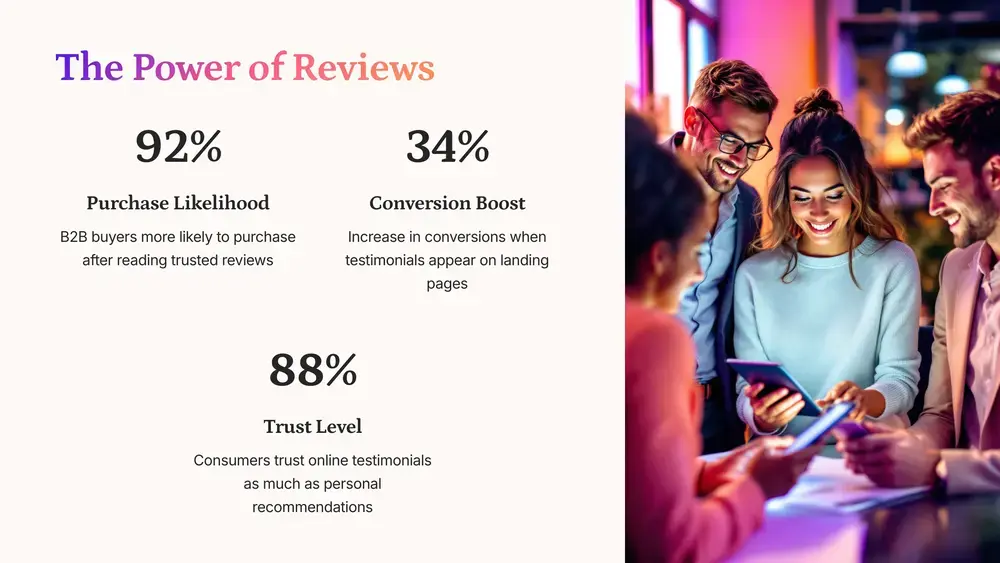Website Audit for Lead Generation: CEO's GA4 Guide

Share this post
Executive Summary:
Your 10,000+ monthly website visitors aren't converting into enough qualified leads. Most CEOs focus on traffic volume instead of conversion optimization, missing opportunities hiding in existing data.
Solution: Conduct a systematic website audit for lead generation using Google Analytics 4, focusing on business impact rather than vanity metrics.
Key Findings:
- Conversion rates vary 350% across industries (1.4% to 4.9%)
- Direct traffic represents 20% of visits but is often misattributed
- Personalized CTAs convert 202% better than generic ones
- Most businesses lack structured analytics roadmaps
Critical CEO Questions
- Which high-traffic pages have low conversion rates? (Biggest opportunities)
- Are we attracting qualified prospects or just volume?
- What's our true cost per qualified lead by channel?
- Where do prospects drop out of our conversion funnel?
- Are we optimizing for lead quantity or quality?
Immediate Actions (30 Days)
- Week 1: Audit current GA4 setup and identify conversion gaps
- Week 2: Segment data by lead quality, not just volume
- Week 3: Optimize top 3 high-traffic, low-conversion pages
- Week 4: Establish ongoing monitoring of business-critical metrics
Expected ROI Impact: Small conversion rate improvements (0.5% to 1.2%) can generate 60% more leads from existing traffic – no additional marketing spend required.
You likely have enough traffic to double leads. The question is whether you'll find these opportunities before competitors do. (full article below)
Your marketing team presents their monthly report with impressive charts and colorful graphs. Traffic is solid – over 10,000 visitors monthly. Yet your sales pipeline remains frustratingly thin. It's time for a comprehensive website audit for lead generation to uncover what's really happening.
You're not alone. As a CEO in the software space, you understand complex enterprise software, but conducting a website audit using Google Analytics 4 feels like deciphering code written in a foreign language. Meanwhile, your marketing team throws around terms like "bounce rate" and "attribution models" while your lead generation audit reveals stubbornly flat conversion numbers.
Here's the uncomfortable truth from countless website audits: you might already have enough traffic to double your leads – you're just not converting it effectively.
Industry data reveals that across sectors, conversion rates vary dramatically – Food & Beverage sees 4.9% while Home & Furniture manages only 1.4%. In B2B software, particularly niche markets like license management, even small improvements in conversion rate optimization can translate to significant revenue increases when identified through proper website analysis.

This guide will help you conduct a thorough website audit for lead generation using Google Analytics 4, identify conversion optimization opportunities, and perform the lead generation audit that uncovers opportunities hiding in your existing traffic – without requiring you to become a Google Analytics expert.
The Million-Dollar Question: Are You Measuring What Actually Matters in Your Lead Generation Audit?
Why Your Current Website Analysis Might Be Misleading You
Let me ask you directly: When your marketing team shows you that bounce rate chart during your monthly website audit, do you know if a 45% bounce rate is catastrophic or perfectly normal for your industry?
Research shows the median bounce rate across all industries is 44.82%, with Consulting & Professional Services and Information Technology recording the highest bounce rates. For B2B software companies, a comprehensive website audit often reveals that visitors need substantial time to research and evaluate solutions. A high bounce rate might indicate poor targeting, or it might simply reflect the nature of enterprise software buying cycles.
The critical assumption to challenge in your website audit for lead generation: That every metric in your monthly report deserves equal attention.
Reality check for CEOs conducting lead generation audits: Your time is limited. Focus on metrics that directly correlate with revenue:
- Qualified lead volume (not just total leads) - key for conversion optimization
- Cost per qualified lead (not just cost per click) - essential for website analysis
- Lead-to-customer conversion rate (not just website conversion rate) - core to lead generation optimization
- Customer acquisition cost vs. lifetime value - critical for website performance audit
The Attribution Problem That's Costing You Leads (Revealed Through GA4 Analysis)
Here's a scenario that might sound familiar during your website audit: A potential customer discovers your company through a LinkedIn article, visits your website briefly, then returns two weeks later by searching your company name directly and finally requests a demo.
Traditional reporting gives credit to that final "direct" search, ignoring the LinkedIn article that started the journey. Across all companies studied, "direct" traffic made up 20% of overall traffic, but traditional analytics tools often misattribute these conversions during website analysis.
What this means for your lead generation audit: You might be under-investing in the content and channels that actually introduce prospects to your brand while over-investing in final-touch activities.
CEO Action Item for Website Audit: Ask your marketing team to show you the complete customer journey data in Google Analytics 4, not just last-click attribution. GA4 can track multi-touch journeys for comprehensive conversion optimization, but only if configured correctly during your website performance audit.
Reading Your Google Analytics 4 Reports Like a CEO: Focus on Business Impact
The Traffic Volume Trap (Common Website Audit Mistake)
Challenge this assumption during your lead generation audit: More website traffic automatically means more leads.
Consider two scenarios from actual website audits:
- Company A: 15,000 monthly visitors, 0.5% conversion rate = 75 leads
- Company B: 10,000 monthly visitors, 1.2% conversion rate = 120 leads
Company B generates 60% more leads with 33% less traffic. Industry data shows average conversion rates of 3.75% for search and 0.77% for display, but these benchmarks might not apply to your niche market when conducting website analysis.
CEO Question for Your Marketing Team's Lead Generation Audit: "Show me our conversion rate optimization trends over the past 12 months alongside traffic growth. Are we getting better at converting visitors, or just attracting more of them?"
Understanding Your Buyer's Digital Behavior Through GA4 Website Analysis
In enterprise software license management, your buyers aren't impulse purchasers. A thorough website audit for lead generation reveals they research extensively, involve multiple stakeholders, and have complex evaluation processes.
Key behavioral indicators to track in your website performance audit:
- Content consumption depth: Are visitors reading your whitepapers and case studies? (Critical for lead generation optimization)
- Return visit patterns: How many times do prospects visit before converting? (Essential website audit metric)
- Page sequence analysis: What content path leads to demo requests? (Core conversion optimization insight)

Research reveals that personalized call-to-action buttons convert 202% better than generic ones. For your market, this conversion optimization might mean different CTAs for IT directors versus procurement managers versus C-suite executives.
CEO Directive for Website Analysis: Have your team segment Google Analytics 4 data by visitor role/title (if trackable) and create reports showing how different buyer personas interact with your site during the lead generation audit.
The Five Critical Questions Every CEO Should Ask During Their Website Audit for Lead Generation
Question 1: "Which of our website pages are underperforming goldmines?" (Essential Website Analysis)
Look for pages with high traffic but low conversion rates during your website audit. These represent your biggest conversion optimization opportunities because the audience is already there – they're just not being convinced to take action.
Example from a real website audit: Your "Software License Compliance" blog post gets 500 visitors monthly but generates only 2 leads. A competitor's similar page might convert at 2-3%. Small conversion optimization improvements here could double your leads from this page alone.
What to ask your team during lead generation audit: "Show me our top 10 pages by traffic in Google Analytics 4, along with their conversion rates. Which pages have the biggest gap between traffic and conversions?"
Question 2: "Are we attracting the right kind of traffic?" (Critical Website Performance Audit Question)
Not all website visitors are equal. A CTO researching license management solutions is worth 100x more than someone accidentally landing on your site – a key insight from website analysis.
Industry analysis shows that big-ticket buyers often require further details or negotiations, with average call rates across industries at just 1.2%. In enterprise software, this is expected behavior for lead generation optimization – qualified prospects want to speak with experts before committing.
CEO Analysis Framework for Website Audit:
- High-intent traffic indicators: Long session duration on product pages, multiple page visits, downloads of technical resources (track in GA4)
- Low-intent traffic indicators: High bounce rate from blog posts, single-page sessions, quick exits (visible in website analysis)
Question 3: "What's our real cost per qualified lead?" (Essential Lead Generation Audit Metric)
Your marketing team might report cost per lead, but not all leads are created equal in conversion optimization. A CTO at a Fortune 500 company is worth more than an intern doing research – a critical distinction for website audit.
Calculation to demand during lead generation audit:
- Total marketing spend ÷ Number of leads that became sales opportunities
- Compare this across different traffic sources and campaigns in Google Analytics 4
Question 4: "How long does our sales cycle really take, and where do we lose prospects?" (Advanced Website Analysis)
GA4's conversion path analysis can show the complete journey from first visit to conversion, but you need to know what questions to ask during your website performance audit.
CEO-Level Analysis for Lead Generation Optimization:
- Average time from first website visit to demo request (track in website audit)
- Content consumption patterns of prospects who eventually buy (conversion optimization insight)
- Drop-off points in your conversion funnel (critical website analysis finding)
Question 5: "Are we optimizing for quantity or quality?" (Strategic Website Audit Question)
This is the fundamental strategic question for lead generation audit. Small businesses typically operate with lean teams and limited budgets, and your 100-200 person company still needs to be strategic about resource allocation for conversion optimization.
Strategic Trade-offs in Website Analysis:
- More traffic requires content marketing and SEO investment
- Higher conversion rates require UX optimization and better targeting (conversion optimization focus)
- Better lead quality requires more sophisticated scoring and nurturing (advanced lead generation audit)
Making Sense of Technical Jargon: A CEO's Translation Guide for Google Analytics 4
When your marketing team presents website audit reports, here's how to translate technical terms into business impact for lead generation optimization:
"Bounce Rate is 48%" (Website Analysis Finding)
Translation: Nearly half of visitors leave immediately after viewing one page. CEO Question for Website Audit: "Is this because we're attracting the wrong audience, or because our messaging isn't compelling enough for conversion optimization?"
"Average Session Duration is 3 minutes" (GA4 Website Performance Metric)
Translation: Visitors spend 3 minutes on average exploring your site. CEO Context for Lead Generation Audit: For enterprise software, this might be normal (they're scanning) or problematic (they're not finding what they need). Compare to industry benchmarks during website analysis.
"Organic Traffic Converts at 2.1%" (Conversion Optimization Metric)
Translation: About 2 out of every 100 organic search visitors take a desired action. CEO Strategic Question for Website Audit: "Is this acceptable for our industry and deal size, or do we have room for conversion optimization?"
"Direct Traffic is 25% of Total" (Website Analysis Insight)
Translation: A quarter of visitors come by typing your URL directly or from bookmarks. CEO Insight for Lead Generation Audit: This often indicates brand awareness and returning prospects – valuable for B2B conversion optimization.
Red Flags That Should Worry Any CEO During Website Audit for Lead Generation
Red Flag #1: Conversion Rates Declining While Traffic Increases (Website Analysis Warning)
This suggests you're attracting less qualified traffic over time during your lead generation audit. Your marketing might be optimizing for the wrong metrics instead of focusing on conversion optimization.
Red Flag #2: High Traffic to Product Pages, Low Demo Requests (Website Performance Audit Issue)
Prospects are interested enough to research your solution but aren't converting. This often indicates unclear value proposition, missing trust signals, or complicated conversion processes – key findings in website analysis.
Red Flag #3: Mobile Traffic High, Mobile Conversions Low (GA4 Analysis Finding)
Industry data shows mobile conversion challenges, with some sectors seeing significantly lower mobile conversion rates. In B2B software, this might be acceptable (enterprise buyers often research on mobile, decide on desktop), but it's worth investigating during conversion optimization.
Red Flag #4: No Clear Content Performance Patterns (Lead Generation Audit Gap)
If you can't identify which content types drive the most qualified leads during website analysis, you're essentially throwing marketing darts blindfolded.
Your 30-Day Website Audit for Lead Generation Action Plan
Week 1: Audit Your Current Reporting (Foundation of Website Analysis)
CEO Tasks for Lead Generation Audit:
- Review last 3 months of marketing reports for conversion optimization opportunities
- Identify which metrics directly correlate with sales pipeline in Google Analytics 4
- Note which metrics you don't understand but are being reported regularly
Questions for Your Team During Website Audit:
- "Show me conversion rates by traffic source, not just traffic volume" (essential website analysis)
- "Which pages generate our highest-value leads?" (critical for lead generation optimization)
- "What's our complete cost-per-acquisition by channel?" (website performance audit metric)
Week 2: Demand Better Data Segmentation (Advanced Website Analysis)
CEO Directives for Lead Generation Audit:
- Request visitor data segmented by company size (if trackable in GA4)
- Ask for content performance analysis focused on lead quality, not quantity (conversion optimization focus)
- Require multi-touch attribution reporting for enterprise deals (comprehensive website audit)
Week 3: Focus on High-Impact Optimizations (Conversion Optimization Priority)
Strategic Priorities for Website Analysis:
- Identify top 3 high-traffic, low-conversion pages for optimization
- Review mobile experience for key conversion paths (mobile website audit)
- Analyze competitor content that might be out-performing yours (competitive lead generation audit)
Week 4: Establish Ongoing Monitoring (Systematic Website Performance Audit)
CEO Systems for Lead Generation Optimization:
- Create simple dashboard with only metrics that matter for business decisions
- Establish monthly reviews focused on lead quality trends (ongoing website analysis)
- Set up alerts for significant changes in key conversion metrics in Google Analytics 4
Advanced Website Audit Techniques for Lead Generation Using GA4
Conversion Funnel Analysis (Core Website Analysis Method)
Use Google Analytics 4 to map your complete conversion funnel:
- Awareness Stage: Blog posts, resource downloads (track in website audit)
- Consideration Stage: Product pages, pricing views (conversion optimization focus)
- Decision Stage: Demo requests, contact forms (lead generation audit priority)
User Journey Mapping (Advanced Website Performance Audit)
GA4's path exploration reports reveal how prospects move through your site:
- Entry points: Where qualified leads typically start (website analysis insight)
- Content sequence: What information they consume before converting (lead generation optimization)
- Exit points: Where you lose potential customers (conversion optimization opportunity)
Lead Scoring Through Website Analysis
Implement behavioral scoring based on GA4 data:
- High-value actions: Product demo views, pricing page visits, case study downloads
- Medium-value actions: Blog post engagement, resource center visits
- Low-value actions: Career page views, general browsing
The Bottom Line: ROI-Focused Website Audit for Lead Generation
As a CEO, you don't need to become a Google Analytics 4 expert. You need to ensure your team is conducting thorough website audits that extract actionable insights directly impacting your bottom line through conversion optimization.
The fundamental questions your lead generation audit should answer:
- Are we attracting the right prospects to our website? (Website analysis priority)
- Are we converting those prospects effectively? (Conversion optimization focus)
- Which marketing investments generate the highest-quality leads? (ROI-focused website audit)
- Where are we losing qualified prospects in the conversion process? (Website performance audit insight)
Research shows that businesses often lack a clear analytics roadmap and have no structured plan for measuring and optimizing their processes. Don't let this be your company's website audit approach.
Your competitive advantage in the software license management space doesn't come from having the most sophisticated website analysis setup. It comes from asking better questions during your lead generation audit and making strategic decisions based on conversion optimization evidence rather than assumptions.
Your next action: Schedule a meeting with your marketing team. Don't ask for more data – ask for clearer insights from your website audit for lead generation that directly connect website performance to your sales pipeline and revenue goals.
The leads are already there in your existing traffic. Your comprehensive website audit using Google Analytics 4 will help you find them before your competitors do.




